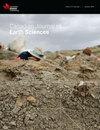Analysis of chemical weathering trends across three compositional dimensions: applications to modern and ancient mafic-rock weathering profiles
IF 1.6
4区 地球科学
Q3 GEOSCIENCES, MULTIDISCIPLINARY
引用次数: 3
Abstract
Chemical weathering indices (one-dimensional/1D index values) and accompanying ternary plots (two-dimensional/2D compositional space) facilitate quantitative comparison of whole-rock and mineral major-element data, and empirical chemical trends with predicted weathering vectors. However, data analysis in ternary plots is restricted by poles grouping elements that are hosted in different minerals or that are influenced selectively by later alteration (e.g., diagenesis/metasomatism). Tetrahedral plots (three-dimensional/3D compositional space) offer enhanced analytical utility of major-element data by shifting elements across four poles and/or incorporating additional proxy elements. Tetrahedral space can better reveal combined effects on major-element compositions from independent mineralogical controls and post-depositional alteration via curvilinear trends that are otherwise simplified and linear in ternary space. This study focuses on mafic rock weathering and first reviews applications and limitations of the 1D mafic index of alteration (MIA) and index of lateritization/bauxitization (IOL/IOB) that integrate into molar Al2O3–CaO*–Na2O–K2O–(FeO(T)/Fe2O3(T))–MgO and SiO2–Al2O3–Fe2O3(T) ternary compositional space, respectively. Analysis in tetrahedral space is then demonstrated with Phanerozoic weathering profile and Precambrian paleosol data in two plots of the molar Al2O3–CaO*–Na2O–K2O–(FeO(T)/Fe2O3(T))–MgO system (A–CN–K–FM and AF–CN–K–M plots) and one plot of the molar Al2O3–CaO*–Na2O–K2O–(FeO(T)/Fe2O3(T))–MgO–SiO2 system (A–L–F–S plot). Common chemical weathering indices are integrated into these 3D tetrahedral spaces or onto some of their 2D ternary faces. However, the tetrahedral compositional space is a key to: (1) assessing integrative effects from labile element loss while accounting for the variable, redox-dependent behaviour of Fe, (2) better exposing, and correcting for, overprinting effects of diagenesis/metasomatism, and (3) tracking Si loss across all stages of chemical weathering.化学风化趋势在三个成分维度上的分析:在现代和古代镁质岩石风化剖面上的应用
化学风化指数(一维/一维指标值)和伴随的三元图(二维/二维成分空间)便于对整个岩石和矿物主要元素数据进行定量比较,并将经验化学趋势与预测的风化向量进行比较。然而,三元图中的数据分析受到极点分组元素的限制,这些元素是在不同矿物中存在的,或受到后来的蚀变(例如成岩作用/交代作用)的选择性影响。四面体图(三维/3D组成空间)通过在四个极点之间移动元素和/或合并额外的代理元素,增强了主要元素数据的分析效用。四面体空间可以更好地揭示独立矿物学控制和沉积后蚀变对主要元素组成的综合影响,其曲线趋势在三元空间中是简化和线性的。本文以基性岩石风化作用为研究重点,首先综述了Al2O3-CaO * - na2o - k2o - (FeO(T)/Fe2O3(T)) - mgo和SiO2-Al2O3-Fe2O3 (T)三元组成空间的一维基性蚀变指数(MIA)和红土化/铝土化指数(IOL/IOB)的应用和局限性。利用显生宙风化剖面和前寒武纪古土壤资料,对两个Al2O3-CaO * - na2o - k2o - (FeO(T)/Fe2O3(T)) - mgo体系图(A-CN-K-FM和AF-CN-K-M图)和一个Al2O3-CaO * - na2o - k2o - (FeO(T)/Fe2O3(T)) - mgo - sio2体系图(A-L-F-S图)进行了四面体空间分析。常见的化学风化指标被整合到这些三维四面体空间或它们的一些二维三元面上。然而,四面体组成空间是以下方面的关键:(1)评估不稳定元素损失的综合影响,同时考虑铁的可变氧化还原依赖行为;(2)更好地暴露和纠正成岩/交代的套印效应;(3)跟踪化学风化所有阶段的硅损失。
本文章由计算机程序翻译,如有差异,请以英文原文为准。
求助全文
约1分钟内获得全文
求助全文
来源期刊

Canadian Journal of Earth Sciences
地学-地球科学综合
CiteScore
2.80
自引率
7.10%
发文量
66
审稿时长
6-12 weeks
期刊介绍:
The Canadian Journal of Earth Sciences reports current research in climate and environmental geoscience; geoarchaeology and forensic geoscience; geochronology and geochemistry; geophysics; GIS and geomatics; hydrology; mineralogy and petrology; mining and engineering geology; ore deposits and economic geology; paleontology, petroleum geology and basin analysis; physical geography and Quaternary geoscience; planetary geoscience; sedimentology and stratigraphy; soil sciences; and structural geology and tectonics. It also publishes special issues that focus on information and studies about a particular segment of earth sciences.
 求助内容:
求助内容: 应助结果提醒方式:
应助结果提醒方式:


